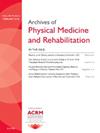Reliability and Construct Validity of Three Self-report Questionnaires Assessing Dual-Task Difficulties in People With Multiple Sclerosis: An International Study
IF 3.6
2区 医学
Q1 REHABILITATION
Archives of physical medicine and rehabilitation
Pub Date : 2025-02-01
DOI:10.1016/j.apmr.2024.08.024
引用次数: 0
Abstract
Objective
To evaluate the reliability and validity of the dual-tasking questionnaire (DTQ), dual-task screening list (DTSL), and dual-task impact on daily life activities questionnaire (DIDA-Q).
Design
Multicenter, cross-sectional study
Setting
Persons with multiple sclerosis (pwMS) were recruited from 7 multiple sclerosis centers across 6 countries (Belgium, Chile, Italy, Israel, Spain, and Turkey).
Participants
A total of 356 pwMS (mean age 47.5±11.5y, expanded disability status scale, 3.79±1.83) were enrolled.
Interventions
Not applicable
Main Outcome Measures
The reliability (internal consistency, test-retest, and measurement error) and construct validity (structural and convergent) were assessed.
Results
The DTQ, DTSL, and DIDA-Q demonstrated excellent test-retest reliability (intraclass correlation coefficients [95% CI], 0.84 [0.80-0.87] to 0.90 [0.87-0.92]) and internal consistency (Cronbach α: 0.86-0.96). As hypothesized, the 3 questionnaires showed a strong correlation with each other, moderate-to-strong correlations with other self-report questionnaires (perceived walking difficulties, fatigue, and fear of falling), and low-to-moderate correlations with cognitive information processing speed, manual dexterity, and dual-task walking performance (walking with word list generation task), showing convergent validity. The DIDA-Q exhibited systematically superior properties. These results were also verified in subsets from 6 different countries. In the structural validity analysis, all questionnaires displayed 2 main factors, allocated as “motor-driven” and “cognitive-driven” subscales.
Conclusions
The DTQ, DTSL, and DIDA-Q have good-to-excellent measurement properties, with the highest properties observed in DIDA-Q. The use of these self-reported questionnaires can be used in research and clinical practice to assess the effect of dual-task difficulties on the daily life of ambulatory pwMS.
评估多发性硬化症患者双重任务困难的三种自我报告问卷的可靠性和结构有效性:一项国际研究。
目的评估双重任务问卷(DTQ)、双重任务筛查表(DTSL)和双重任务对日常生活活动的影响问卷(DIDA-Q)的可靠性和有效性:多中心横断面研究:从六个国家(比利时、智利、意大利、以色列、西班牙和土耳其)的七个多发性硬化症中心招募患者:干预措施:主要结果测量:评估信度(内部一致性、重测和测量误差)和构架效度(结构效度和聚合效度):结果:DTQ、DTSL 和 DIDA-Q 均表现出极佳的重测可靠性[类内相关系数 (95% CI):0.84 (0.80-0.87) 至 0.90 (0.87-0.92)]和内部一致性(Cronbach's α:0.86 至 0.96)。正如假设的那样,这三份问卷之间有很强的相关性,与其他自我报告问卷(感知行走困难、疲劳和害怕跌倒)之间有中等到较强的相关性,与认知信息处理速度、手部灵活性和双任务行走表现(行走与单词表生成任务)之间有低到中等的相关性,显示了趋同效度。DIDA-Q表现出系统的优越性。来自六个不同国家的子集也验证了这些结果。在结构效度分析中,所有问卷都显示出两个主要因素,分别为 "运动驱动 "和 "认知驱动 "子量表:结论:DTQ、DTSL 和 DIDA-Q 具有良好到卓越的测量特性,其中 DIDA-Q 的测量特性最高。在研究和临床实践中,可以使用这些自我报告问卷来评估双重任务困难对行动不便的残疾人日常生活的影响。
本文章由计算机程序翻译,如有差异,请以英文原文为准。
求助全文
约1分钟内获得全文
求助全文
来源期刊
CiteScore
6.20
自引率
4.70%
发文量
495
审稿时长
38 days
期刊介绍:
The Archives of Physical Medicine and Rehabilitation publishes original, peer-reviewed research and clinical reports on important trends and developments in physical medicine and rehabilitation and related fields. This international journal brings researchers and clinicians authoritative information on the therapeutic utilization of physical, behavioral and pharmaceutical agents in providing comprehensive care for individuals with chronic illness and disabilities.
Archives began publication in 1920, publishes monthly, and is the official journal of the American Congress of Rehabilitation Medicine. Its papers are cited more often than any other rehabilitation journal.

 求助内容:
求助内容: 应助结果提醒方式:
应助结果提醒方式:


